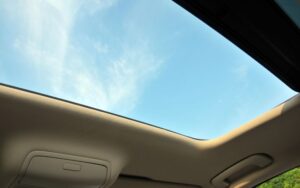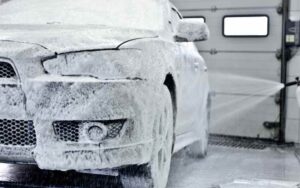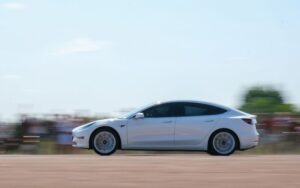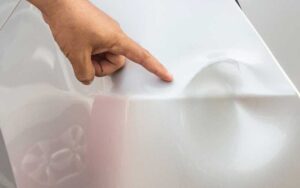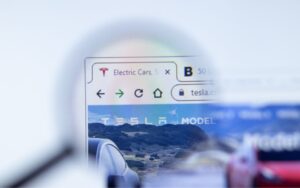Tesla Tire Rotation: All You Need To Know
Last updated on September 12th, 2023 at 03:04 am
Tire rotation is an essential tire maintenance procedure that people often overlook, even though it significantly affects a tire’s lifespan.
Tesla’s drivetrain affects the wear ratio of the front and rear tires, but tire rotation evens out the wear.
The rotation process places the least worn tires on the driving wheel and the most worn on the non-driving wheel.
Thus, rotating your Tesla tires is a prerequisite for safety and functionality.
Tesla tires wear out quickly. Thus, you should rotate them after driving for 6,250 miles. The tires of Tesla electric vehicles are rotated according to the recommended tire rotation sequence (rear-wheel drive and all-wheel drive). Tesla’s RWD models, like the Model X, use the reverse cross-tire rotation pattern, while AWD Teslas use the cross-X tire rotation pattern.
In this article, I will tell you the best tire rotation sequence for your Tesla, whether a model 3, S, X, or Y. I’ll also help you choose the best sequence based on your drive configuration.
What is the Tire Rotation Recommendation For Tesla?
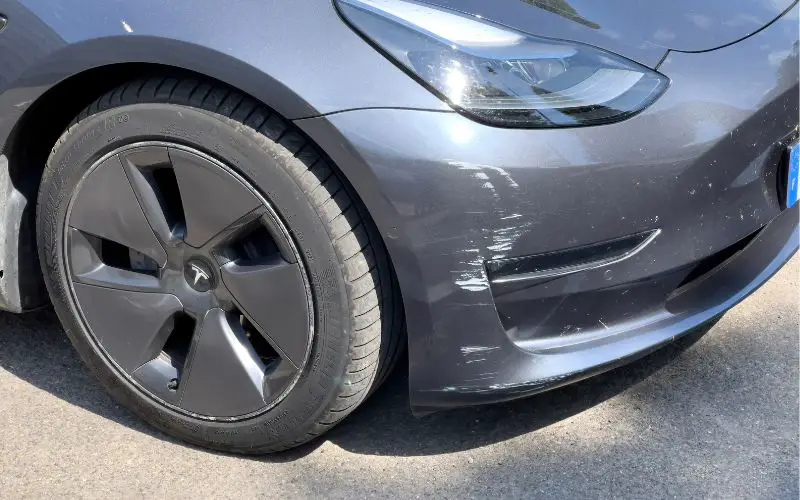
Tesla’s recommended distance before a tire rotation is about 6,250 miles/ 10,000 Km or after 2/32 inch/1.5mm of worn thread.
If you have owned an ICE vehicle before, you would have noticed that Tesla tires wear down faster.
One of the major causes of this increased tire wear is because of the heaviness of electric vehicles.
Tesla’s response to their vehicles’ uneven and rapid tire wear was to discontinue their RWD lineups, use better quality tires, and switch to AWD to reduce tire strain.
Tire rotation recommendations for Teslas vary based on the model and drive train.
Here are the recommended tire rotation sequence for Tesla Models 3, X, Y, and S:
#1. Tesla Model 3
The Tesla Model 3 has rear-wheel drive (RWD) and all-wheel drive (AWD) models with different tire rotation sequences.
The rear-wheel drive (RWD) model of the Tesla Model 3 follows the typical cross-tire rotation pattern of RWD vehicles.
Below is a description of the process.
- Transfer the rear tires to the front.
- Switch the left front tire to the right wheel behind.
- Transfer the right front tire to the rear left wheel.
The all-wheel drive (AWD) Tesla Model 3 should follow the sequences below based on how forward or rear-biased the drive train is.
- 50/50 power distribution tires should use a cross-pattern rotation. Switch the front right tire to the left rear and the right rear to the front rear.
- Forward or rear-biased drivetrains can be rotated like an FWD for forward-biased and rotated like RWD for rear-biased drive modes.
#2. Tesla Model X
The Tesla Model X has a rear-biased AWD drivetrain, which means you can rotate the tires like an RWD or an AWD, depending on the degree of wear.
#3. Tesla Model Y
The Tesla Model Y has two different models; the RWD model has a lithium polymer battery pack, while the AWD version uses a traditional lithium-ion battery.
It would be best to use the reverse cross tire rotation for the RWD model Y and the cross X for the AWD version.
#4. Tesla Model S
The Tesla Model S plaid is the fastest-accelerating Tesla vehicle. Its three electric motors create a whooping 1000+ plus HP paired with an AWD drivetrain.
If you drive your Model S hard, replace all your tires at once when worn sufficiently.
The model S is an AWD, so you should practice cross-X tire rotation after about 6,250 miles.
What is the Recommended Tire Rotation Sequence?
The recommended tire rotation sequence varies based on the drivetrain and transmission.
The front-wheel drive uses a forward cross pattern, the rear-wheel drive uses a rear cross, and the all-wheel drive uses a double cross.
You should note that you cannot cross-rotate tires with different sizes/radii; you can only rotate them from left to right, granted they are omnidirectional tires.
So, I will describe the recommended rotation sequence for omnidirectional tires to facilitate your understanding.
Beneath are the recommended rotation sequence of FWD, RWD, and AWD.
#1. Front Wheel Drive(FWD)
FWD is the most used kind of drivetrain in the world today. They are easy to maintain and have the most minor tire wear among all drive trains.
The following is the rotation sequence for front-wheel drives.
- Move the two front tires to the back.
- The left-back tire should go on the right-front wheel.
- The right-back tire should go on the front-left wheel.
#2. Rear Wheel Drive(RWD)
Rear-wheel drive drivetrains are popular on sporty and high-performance vehicles. RWD tire rotation procedure is the opposite of that of AWD.
- Move the rear wheels to the front.
- Transfer the left front tire to the right back wheel.
- Transfer The right front tire to the rear left wheel.
#3. All Wheel Drive( AWD)
Tire rotation is not necessary for all-wheel drive (4×4) but is crucial. Compared to other drivetrains, AWD wears down tires evenly, making replacing them more manageable.
So, here is how to rotate an AWD’s tires.
- The front left tire should go on the rear right wheel.
- The front right tire should go on the rear left wheel.
- The rear left tire should go on the front right wheel.
- The rear right tire should go on the front left wheel
Can you Rotate Tesla Performance Tires?
Yes, you can rotate Tesla Performance tires. Tesla Performance tires are special high-quality tires Tesla uses on their top-of-the-line AWD models.
Tesla Model X plaid, Model S, and Model S plaid all use Tesla high-performance tires.
Tesla performance tires are exceptional and advantageous owing to the features below.
#1. Reduced Rolling Resistance
Tesla Performance tires have very little roll resistance, which allows them to maintain low and high speeds on the road without spending too much energy.
#2. Improved Grip/ Handling
Tesla Model S plaid high-performance tires generate enough grip to allow 0-60 mph runs in under 2.5 seconds.
Although Teslas are pretty heavy, their tires produce enough grip for quick and snappy handling.
#3. Lesser Tire Road Noise
The loudest sound in the cabin of a Tesla isn’t the whine of its electric motors but the sound of the tires rolling on the road.
The sound of the tires on the road can go as high as 70 dB, which can get annoying after a while.
Tesla’s response to this problem was to install a special acoustic foam in the interior of their high-performance tires to reduce noise on the highway.
What are the Disadvantages of Tesla Tire Rotation?
There are not many disadvantages to performing a tire rotation on your Tesla, the advantages of tire rotation far outweigh the disadvantages.
Below is a table containing the pros and cons of performing a Tesla Tire rotation.
| Advantages of Tesla Tire Rotation | Disadvantages of Tesla Tire Rotation |
|---|---|
| It reduces uneven wear and tear | Tire rotation might be expensive |
| It improves vehicle response and handling | Tesla’s warranty does not cover tire rotation |
| Lowers the chance of your car hydroplaning in wet weather | |
| Lengthens the life of your tires |
Ultimately we rotate the tires of our cars to reduce wear and lengthen their lifespan. But tire rotation is not the only way to improve a tire’s lifespan.
So, here are other ways to reduce tire wear and tear.
#1. Gauge Your Tires Properly
Driving with an overinflated or underinflated tire is a terrible practice that will damage your tires and cause blowouts that might lead to death or injuries.
Read your user manual before you attempt inflating your car tires; there are signs on the sidewall of tires indicating its recommended PSI and the maximum load it can carry.
Driving with underinflated tires is dangerous because the tire will heat up, and the thread will wear down until it fails catastrophically.
#2. Avoid Sudden Acceleration
Sudden and rapid acceleration wears out thread from the tires of cars, especially when the rubber is cold and hard.
So, if you wish to take your car for a spin, buy a new set of race tires. Also, go to a race track if you want to drive fast.
#3. Brake Gently
Frequent acceleration and sudden braking wear down tires quickly. Racing or driving at high speeds is very dangerous, especially on public roads, and it affects the threads of your tire.
If you want to lengthen your tire lifespan, drive responsibly at or below the speed limit.
Doing this will also increase your MPG and give you enough time to stop in case of emergencies.
What happens if the Tire Rotation is in the Wrong Direction?
If the tire rotates in the wrong direction, it will experience faster thread wear, loss of braking power, and poor handling.
There are two types of tires based on the direction they rotate: omnidirectional and unidirectional.
As the name suggests, omnidirectional tires can rotate forward or backward without losing performance, while unidirectional tires must rotate facing a particular axis.
Here are some things that will happen if a unidirectional tire faces the wrong direction.
- Quicker tread wear
- Noisy driving
- Poor handling
- Loss of braking power

Hey, I’m Michael Davis, a 35-year-old with a degree and a love for cars and tech. Since I was a kid, cars have been my thing—so much that I even thought they ran on magic beans! Fast forward, and I’ve built Vehicle Army, your one-stop-shop for easy-to-understand car facts.

